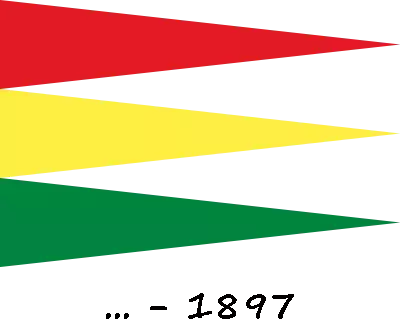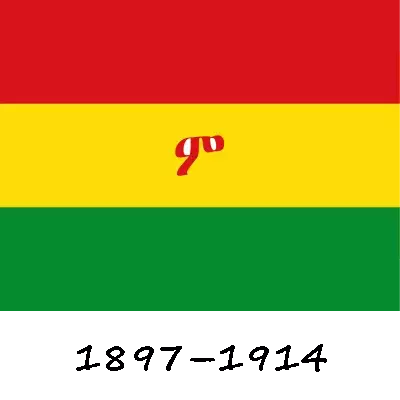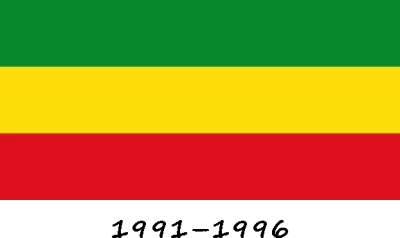- The green color symbolizes peace and harmony and represents the fertility and richness of the country's land;
- The yellow color symbolizes justice and equality, when all ethnic groups and religions of the country live together in harmony. Yellow is also associated with gold - wealth, grandeur and spirituality;
- Red is a symbol of struggle. It honors the memory of the heroes who defended sovereignty, independence and freedom;
- The blue disk in the center symbolizes peace, harmony and stability, and the round shape reflects the integrity and indivisibility of the country;
- The golden rays emanating from the star between its corners symbolize the principles on which the country is built: Unity, Peace, Equality, Freedom, Progress;
- The five-pointed golden star placed inside the blue disk symbolizes the unity of all ethnic groups, religions and diversity of cultures. Although Ethiopia is made up of more than 80 different ethnic groups, five main ones can be distinguished:
The Oromo are the largest ethnic group in Ethiopia, making up approximately 34-35% of the country's total population (over 40 million people). The Oromo have their own language, Afan Oromo, which belongs to the Kushitic language family;
The Amhara are the second largest ethnic group, accounting for about 27% of the country's population (approximately 30 million people). The Amhara have historically been associated with the central government of Ethiopia, and their language, Amharic, is the official language of the country. Representatives of this group often played leading roles in the historical elite, including emperors;
Tigray - the group makes up about 7% of Ethiopia's population (over 7 million people). They live mainly in the north of the country, in the Tigray region, which was the center of the ancient Axum Kingdom;
Somalia - ethnic Somalis make up about 6% of the population (over 6 million people) and live mainly in eastern Ethiopia. Somalis also live in Somalia, Djibouti, and Kenya;
The Sidano (Southern Peoples) is a collective name for more than 50 smaller ethnic groups living in Southern Ethiopia, including the Sidama, Wolaita, Gurrage, and others. Together they make up approximately 20% of the country's population;
The careful reader will notice that these 5 groups make up over 95% of the population, with the remaining approximately 5-6% coming from smaller ethnic groups such as the Afar, Nuer, Anuak and others who also have their own unique cultures and languages.
The History of Ethiopia’s Flag
Long before Ethiopia had an official flag, three colors—green, yellow, and red—danced across its lands. They appeared on banners or pennants, carrying deep meaning for the Ethiopian Orthodox Church. Green spoke of fertile fields and hope for a brighter day. Yellow shone with peace, wealth, and the church’s sanctity. Red stood for the blood shed for faith and freedom. To Ethiopians, these weren’t just colors—they wove together the spirit of the people, their bond with God, and their land. Some say they echoed the rainbow from the Book of Genesis, symbolizing the Holy Trinity: Father, Son, and Holy Spirit.

On October 6, 1897, Emperor Menelik II raised Ethiopia’s first official flag. Three stripes stacked together: red at the top, yellow in the middle, green at the bottom. On the yellow stripe stood the Amharic letter "ም"—Menelik’s mark. Red called to mind the blood spilled for freedom. Yellow promised peace and unity among the people. Green sang of fertile lands and hope.
This flag was born after the victory at Adwa in 1896, when Ethiopians crushed Italian invaders. Picture it waving proudly over the battlefield, as if declaring, “Ethiopia is free!” This flag became the nation’s first bold statement to the world.

When Menelik II passed in 1913, the flag changed. The letter "ም" vanished, and the colors shifted: green now on top, followed by yellow, then red. Often, the Lion of Judah appeared—a crowned lion holding a cross, symbol of the Solomonic dynasty, tracing its roots to the Queen of Sheba and King Solomon. The Lion of Judah gazed out, as if saying, “Here, God and emperor reign.”
In 1936, Italian troops invaded Ethiopia, and the national flag vanished from the skies. In its place flew a foreign one—the Italian tricolor: vertical stripes of green, white, and red, with the Savoy dynasty’s emblem in the center. The emblem showed a shield with a white cross on a red field. These colors meant nothing to Ethiopia’s soul: green for Italy’s plains, white for purity, red for imperial blood. To Ethiopians, this flag was a bitter sign of oppression, while their true flag lived on in their hearts, awaiting freedom.

In 1941, when the Italians were driven out with British help, the Lion of Judah roared again. Haile Selassie I had cemented its design in law back in 1932. The lion with its crown and cross became the flag’s heart, the colors its soul. It was a time when Ethiopia tried to keep pace with the modern world, but storms were brewing that would topple the monarchy.
In 1974, Haile Selassie I lost his throne, and the flag changed. The lion’s crown was gone, its cross replaced by a spear—a sign the monarchy was over. The flag stayed a tricolor: green on top, yellow in the middle, red below. But the colors lost their sacred spark: green now just hinted at the land, yellow at peace, red at struggle. This flag was like a bridge—old Ethiopia fading, new Ethiopia yet to come.

With the Derg’s rise in 1975, the flag often flew as a plain tricolor—green, yellow, red—in everyday life. But for official moments, they added an emblem: a plow against a yellow sun in a blue circle, framed by a green garland of wheat, sometimes topped with a red star. The plow hailed farmers’ labor, the sun a bright future, the garland the harvest. Green stood for progress, yellow for hope of equality, red for the blood of a new era. This flag mirrored socialist dreams, though not always joyful ones.
In 1987, under Mengistu Haile Mariam, the flag took on a new look. The tricolor remained, but a bold emblem graced the center: a yellow five-pointed star on a red disc, with Aksum’s obelisk, a gear, olive branches, and a rising sun below. Above it, in Amharic, glowed the words "የኢትዮጵያ ሕዝባዊ ዲሞክራሲያዊ ሪፐብሊክ"—People’s Democratic Republic of Ethiopia. The star burned with revolutionary fire, the gear praised labor, the obelisk recalled ancient glory. Green meant progress, yellow unity, red struggle. But this flag didn’t last long—by 1991, the Derg fell.

In 1991, when the Derg collapsed, Ethiopia seemed to catch its breath after years of turmoil. The flag returned to a simple tricolor: green on top, yellow in the middle, red below—no emblems or stars. It was like a blank canvas for a new chapter. Green celebrated the land and rebirth, yellow hope for peace, red the memory of those who fought. In 1992, it was named the state symbol of the transitional government. Simple but heartfelt, it flew over a nation finding its way, uniting people in dreams of a better tomorrow.
On October 31, 1996, Ethiopia unveiled the flag that flies today. Three stripes—green, yellow, red—joined by a blue disc at the center, where a five-pointed star with rays shines. Its proportions are 1:2.
Every part carries meaning:
- Green for labor, progress, and fertile fields.
- Yellow for hope that warms the heart.
- Red for the blood shed for freedom.
- The blue disc for the peace the nation craves.
- The star and its rays for the unity of Ethiopia’s peoples and their dream of a bright future.
Born after the 1995 Constitution, when Ethiopia became a federation, this flag embraces all its peoples, whispering, “Together, we’re stronger.” When you see it ripple in the breeze today, it feels like the soul of Ethiopia—its past and its hope for what’s to come.








